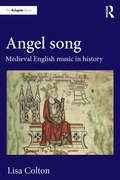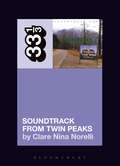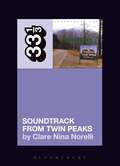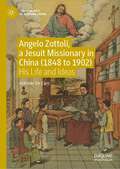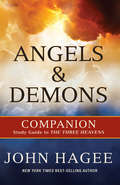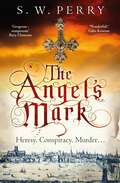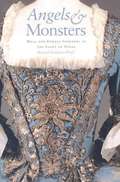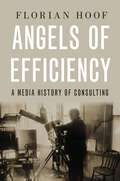- Table View
- List View
Angel Song: Medieval English Music in History
by Lisa ColtonAlthough medieval English music has been relatively neglected in comparison with repertoire from France and Italy, there are few classical musicians today who have not listened to the thirteenth-century song ‘Sumer is icumen in’, or read of the achievements and fame of fifteenth-century composer John Dunstaple. Similarly, the identification of a distinctively English musical style (sometimes understood as the contenance angloise) has been made on numerous occasions by writers exploring the extent to which English ideas influenced polyphonic composition abroad. Angel song: Medieval English music in history examines the ways in which the standard narratives of English musical history have been crafted, from the Middle Ages to the present. Colton challenges the way in which the concept of a canon of English music has been built around a handful of pieces, composers and practices, each of which offers opportunities for a reappraisal of English musical and devotional cultures between 1250 and 1460.
Angela Carter and Western Philosophy
by Heidi YeandleThis book unearths Carter’s deconstruction of the male-dominated discipline of Western thought. Revealing the extensive philosophical research that underpins Carter’s intertextual work, this book offers new readings of her fiction in relation to a range of philosophical texts and ideas. By re-examining Carter’s writing with reference to the archived collection of her notes that has recently become available at the British Library, Angela Carter and Western Philosophy puts forward new interpretations of Carter’s writing practices. With chapters examining her allusions to Plato, Hobbes and Rousseau, Descartes, Locke and Hume, Wittgenstein and Ryle, as well as Kant and Sade, this book illuminates Carter’s engagement with different areas of Western thought, and discusses how this shapes her portrayal of reality, identity, civilisation, and morality. Angela Carter and Western Philosophy will be of interest to researchers, lecturers, and students working on contemporary women’s writing, philosophy and literature, and intertextual literary practices.
Angela Merkels Überzeugungen in der Eurokrise: Eine Operational Code Analyse (Globale Gesellschaft und internationale Beziehungen)
by Danae AnkelKönnen die Überzeugungen einzelner Entscheidungsträger die Außenpolitik eines Staates beeinflussen? Bestimmte Angela Merkels „belief system“ während der Griechenlandkrise von 2010 bis 2015 die deutsche Außenpolitik? Danae Ankel untersucht zunächst Merkels Überzeugungen in der Griechenlandkrise, um anschließend zu analysieren, ob ihre Überzeugungen Einfluss auf die deutschen außenpolitischen Entscheidungen in der Krise hatten. Die Kernthesen dieser Operational Code Analyse lauten: „who leads matters“ und „beliefs matter“. Das Buch liefert einen Beitrag zu den deutschsprachigen first-image Analysen von Außenpolitik und betont die Bedeutung einzelner Entscheidungsträger für außenpolitische Entscheidungsprozesse.
Angelica's Book and the World of Reading in Late Renaissance Italy (Cultures of Early Modern Europe)
by Brendan Dooley Beat Kümin Brian CowanThrough the lens of a history of material culture mediated by an object, Angelica's Book and the World of Reading in Late Renaissance Italy investigates aspects of women's lives, culture, ideas and the history of the book in early modern Italy. Inside a badly damaged copy of Straparola's 16th-century work, Piacevoli Notti, acquired in a Florentine antique shop in 2010, an inscription is found, attributing ownership to a certain Angelica Baldachini. The discovery sets in motion a series of inquiries, deploying knowledge about calligraphy, orthography, linguistics, dialectology and the socio-psychology of writing, to reveal the person behind the name. Focusing as much on the possible owner as upon the thing owned, Angelica's Book examines the genesis of the Piacevoli Notti and its many editions, including the one in question. The intertwined stories of the book and its owner are set against the backdrop of a Renaissance world, still imperfectly understood, in which literature and reading were subject to regimes of control; and the new information throws aspects of this world into further relief, especially in regard to women's involvement with reading, books and knowledge. The inquiry yields unexpected insights concerning the logic of accidental discovery, the nature of evidence, and the mission of the humanities in a time of global crisis. Angelica's Book and the World of Reading in Late Renaissance Italy is a thought-provoking read for any scholar of early modern Europe and its culture.
Angelica's Book and the World of Reading in Late Renaissance Italy (Cultures of Early Modern Europe)
by Brendan Dooley Beat Kümin Brian CowanThrough the lens of a history of material culture mediated by an object, Angelica's Book and the World of Reading in Late Renaissance Italy investigates aspects of women's lives, culture, ideas and the history of the book in early modern Italy. Inside a badly damaged copy of Straparola's 16th-century work, Piacevoli Notti, acquired in a Florentine antique shop in 2010, an inscription is found, attributing ownership to a certain Angelica Baldachini. The discovery sets in motion a series of inquiries, deploying knowledge about calligraphy, orthography, linguistics, dialectology and the socio-psychology of writing, to reveal the person behind the name. Focusing as much on the possible owner as upon the thing owned, Angelica's Book examines the genesis of the Piacevoli Notti and its many editions, including the one in question. The intertwined stories of the book and its owner are set against the backdrop of a Renaissance world, still imperfectly understood, in which literature and reading were subject to regimes of control; and the new information throws aspects of this world into further relief, especially in regard to women's involvement with reading, books and knowledge. The inquiry yields unexpected insights concerning the logic of accidental discovery, the nature of evidence, and the mission of the humanities in a time of global crisis. Angelica's Book and the World of Reading in Late Renaissance Italy is a thought-provoking read for any scholar of early modern Europe and its culture.
Angelo Badalamenti's Soundtrack from Twin Peaks (33 1/3)
by Clare Nina NorelliWhen Twin Peaks debuted on the ABC network on the night of April 8, 1990, thirty-five million viewers tuned in to some of the most unusual television of their lives. Centered on an eccentric, coffee-loving FBI agent's investigation into the murder of a small town teen queen, Twin Peaks brought the aesthetic of arthouse cinema to a prime time television audience and became a cult sensation in the process.Part of Twin Peaks' charm was its unforgettable soundtrack by Angelo Badalamenti, a longtime musical collaborator of film director and Twin Peaks co-creator David Lynch. Badalamenti's evocative music, with its haunting themes and jazzy moodscapes, served as a constant in a narrative that was often unhinged and went on to become one of the most popular and influential television soundtracks of all time. How did a unique collaborative process between a director and composer result in a perfectly postmodern soundtrack that ran the gamut of musical styles from jazz to dreamy pop to synthesizer doom and beyond? And how did Badalamenti's musical cues work with Twin Peaks' visuals, constantly evolving and playing off viewers' expectations and associations? Under the guidance of Angelo Badalamenti's beautifully dark sonic palette, Clare Nina Norelli delves deep into the world of Twin Peaks to answer all this and more.
Angelo Badalamenti's Soundtrack from Twin Peaks (33 1/3)
by Clare Nina NorelliWhen Twin Peaks debuted on the ABC network on the night of April 8, 1990, thirty-five million viewers tuned in to some of the most unusual television of their lives. Centered on an eccentric, coffee-loving FBI agent's investigation into the murder of a small town teen queen, Twin Peaks brought the aesthetic of arthouse cinema to a prime time television audience and became a cult sensation in the process.Part of Twin Peaks' charm was its unforgettable soundtrack by Angelo Badalamenti, a longtime musical collaborator of film director and Twin Peaks co-creator David Lynch. Badalamenti's evocative music, with its haunting themes and jazzy moodscapes, served as a constant in a narrative that was often unhinged and went on to become one of the most popular and influential television soundtracks of all time. How did a unique collaborative process between a director and composer result in a perfectly postmodern soundtrack that ran the gamut of musical styles from jazz to dreamy pop to synthesizer doom and beyond? And how did Badalamenti's musical cues work with Twin Peaks' visuals, constantly evolving and playing off viewers' expectations and associations? Under the guidance of Angelo Badalamenti's beautifully dark sonic palette, Clare Nina Norelli delves deep into the world of Twin Peaks to answer all this and more.
Angelo Secchi and Nineteenth Century Science: The Multidisciplinary Contributions of a Pioneer and Innovator (Historical & Cultural Astronomy)
by Ileana Chinnici Guy ConsolmagnoAngelo Secchi was a key figure in 19th century science. An Italian Jesuit and scientist, he helped lead the transition from astronomy to astrophysics and left a lasting legacy in the field. Secchi’s spectral classification of stars was a milestone that paved the way for modern astronomical research. He was also a founder of modern meteorology and an innovator in the design and development of new instruments and methods across disciplines.This contributed volume collects together reviews from an international group of historians, scientists and scholars representing the multiple disciplines where Secchi made significant contributions during his remarkable career. It analyzes both his famous and lesser known pioneering efforts with equal vigor, providing a well-rounded narrative of his life’s work. Beyond his scientific and technological work, his role as a Jesuit priest in Rome during the turbulent years of the mid 19th century is also described and placed in the context of his scientific and civic activities.
Angelo Zottoli, a Jesuit Missionary in China: His Life and Ideas (Christianity in Modern China)
by Antonio De CaroThis book offers a study of the cosmogonic works by Fr. Angelo Zottoli S.J., a Jesuit missionary who has received relatively little attention by modern scholars, but who deserves a special recognition for his theological and philosophical ideas. More generally, the book aims to shed light on the importance of cosmogony in the cross-cultural and interdisciplinary environment of Xujiahui, the area in modern Shanghai where Zottoli flourished. It shows how through Zottoli’s teaching and sermons he was able to reimagine his own cosmogonic ideas, his personality, and his relationship with local Chinese converts. Among Zottoli’s most famous students was Ma Xiangbo (馬相伯 1840–1939) and Zottoli played a crucial role in Ma’s intellectual formation.A wider familiarity with Zottoli’s works is not only interesting in and of itself, but also paves the way to future studies on the complex and multifaceted relationship between European missionaries and Chinese students in Shanghai during the nineteenth century.
Angels and Angelology in the Middle Ages
by David KeckRecently angels have made a remarkable comeback in the popular imagination; their real heyday, however, was the Middle Ages. From the great shrines dedicated to Michael the Archangel at Mont-St-Michel and Monte Garano to the elaborate metaphysical speculations of the great thirteenth-century scholastics, angels dominated the physical, temporal, and intellectual landscape of the medieval West. This book offers a full-scale study of angels and angelology in the Middle Ages. Seeking to discover how and why angels became so important in medieval society, David Keck considers a wide range of fascinating questions such as: Why do angels appear on baptismal fonts? How and why did angels become normative for certain members of the church? How did they become a required course of study? Did popular beliefs about angels diverge from the angelologies of the theologians? Why did some heretics claim to derive their authority from heavenly spirits? Keck spreads his net wide in the attempt to catch traces of angels and angelic beliefs in as many portions of the medieval world as possible. Metaphysics and mystery plays, prayers and pilgrimages, Cathars and cathedrals-all these and many more disparate sources taken together reveal a society deeply engaged with angels on all its levels and in some unlikely ways.
Angels and Belief in England, 1480–1700 (Religious Cultures in the Early Modern World)
by Laura SanghaThis study looks at the way the Church utilized the belief in angels to enforce new and evolving doctrine.Angels were used by clergymen of all denominations to support their particular dogma. Sangha examines these various stances and applies the role of angel-belief further, to issues of wider cultural and political significance.
Angels and Belief in England, 1480–1700 (Religious Cultures in the Early Modern World #7)
by Laura SanghaThis study looks at the way the Church utilized the belief in angels to enforce new and evolving doctrine.Angels were used by clergymen of all denominations to support their particular dogma. Sangha examines these various stances and applies the role of angel-belief further, to issues of wider cultural and political significance.
Angels and Demons: A Companion to The Three Heavens
by John HageeAn in-depth, interactive companion study to John Hagee's new bestseller, The Three Heavens.
Angels And Insects: Two Novellas (Vintage International Ser. #Vol. 318)
by A S ByattLike A.S. Byatt’s Booker Prize-winning novel, Possession, these two mesmerising novellas are set in the nineteenth century. In Morpho Eugenia, an explorer realises that the behaviour of the people around him is alarmingly similar to that of the insects he studies. In The Conjugal Angel, curious individuals – some fictional, others drawn from history – gather to connect with the spirit world. Throughout both, Byatt examines the eccentricities of the Victorian era, weaving fact and fiction, reality and romance, science and faith into a sumptuous, magical tapestry.
Angels Cry Sometimes: Her world is torn apart, but love prevails
by Josephine CoxAfter heartbreak, grief and despair, can happiness be found again? Josephine Cox's Angels Cry Sometimes brims with heartbreak and joy, hardship and indomitable spirit, that will hold the reader enthralled. Perfect for fans of Rosie Goodwin and Nadine Dorries. The marriage of Marcia and Curt Ratheter seemed idyllically happy. As much in love as on their wedding day, nothing could mar their joy. But one fateful day in 1931 brought Marcia's world tumbling about her ears and left her and her two daughters bereft.Barty Bendall has always loved her, he says; and the girls need a father. Marcia moves to Blackburn with him, where she tries to forget the past. Barty, though, sinks into bad ways, tyrannizing the family. In particular he vents his aggression on Polly, Curt and Marcia's first-born, blonde as an angel but afflicted since birth with an ominous shadow over her health.Even in troubled times, lovely raven-haired Marcia was a fighter. But the news that Curt Ratheter has reappeared renders her the helpless prey of wildly conflicting emotions. What readers are saying about Angels Cry Sometimes: 'All [Josephine Cox] books really engross me and Angels Cry Sometimes is no exception. Very moving''Enjoyable and realistic characters that we can all identify with''One of the best books I have read in a long time'
Angels in Early Medieval England (Oxford Theology and Religion Monographs)
by Richard SowerbyIn the modern world, angels can often seem to be no more than a symbol, but in the Middle Ages men and women thought differently. Some offered prayers intended to secure the angelic assistance for the living and the dead; others erected stone monuments carved with images of winged figures; and still others made angels the subject of poetic endeavour and theological scholarship. This wealth of material has never been fully explored, and was once dismissed as the detritus of a superstitious age. Angels in Early Medieval England offers a different perspective, by using angels as a prism through which to study the changing religious culture of an unfamiliar age. Focusing on one corner of medieval Europe which produced an abundance of material relating to angels, Richard Sowerby investigates the way that ancient beliefs about angels were preserved and adapted in England during the Anglo-Saxon period. Between the sixth century and the eleventh, the convictions of Anglo-Saxon men and women about the world of the spirits underwent a gradual transformation. This book is the first to explore that transformation, and to show the ways in which the Anglo-Saxons tried to reconcile their religious inheritance with their own perspectives about the world, human nature, and God.
Angels in Early Medieval England (Oxford Theology and Religion Monographs)
by Richard SowerbyIn the modern world, angels can often seem to be no more than a symbol, but in the Middle Ages men and women thought differently. Some offered prayers intended to secure the angelic assistance for the living and the dead; others erected stone monuments carved with images of winged figures; and still others made angels the subject of poetic endeavour and theological scholarship. This wealth of material has never been fully explored, and was once dismissed as the detritus of a superstitious age. Angels in Early Medieval England offers a different perspective, by using angels as a prism through which to study the changing religious culture of an unfamiliar age. Focusing on one corner of medieval Europe which produced an abundance of material relating to angels, Richard Sowerby investigates the way that ancient beliefs about angels were preserved and adapted in England during the Anglo-Saxon period. Between the sixth century and the eleventh, the convictions of Anglo-Saxon men and women about the world of the spirits underwent a gradual transformation. This book is the first to explore that transformation, and to show the ways in which the Anglo-Saxons tried to reconcile their religious inheritance with their own perspectives about the world, human nature, and God.
Angels in the Gloom: An unforgettable novel of war, espionage and secrets (World War 1 Series #3)
by Anne Perry1916, and Britain faces possible starvation. Can a way be found to beat the deadly German U-boats? The third breath-taking novel in Anne Perry's heart-stopping World War I quintet, Angels in Gloom follows the Reavley family as they face danger closer to home. Perfect for fans of Pat Barker and Sebastian Barry.'Perry creates a meticulously detailed backdrop, whether [on the] home front or [the] front lines, while leaving plenty of room for her characters to contemplate issues of honor, loyalty, and love' - BooklistIt's March 1916, and Joseph Reavley is on sick leave and finding recovery slow and hard. His sister Hannah is caring for him at home, and it's a delight to them both when Shanley Corcoran, an old friend, comes to visit. Corcoran confides in Joseph that he's come very close to completing an invention that will paralyse the deadly German U-boats. Soon afterwards, however, the leading scientist on that project is found murdered, and it's clear that someone has been betraying secrets to the enemy. Joseph's brother Matthew, of the S.I.S., comes down to investigate, and together the two men embark on a search that will solve the crime and lead them to the spy. What readers are saying about Angels in the Gloom: 'This is truly a special series''The author's description of war on the Western Front is so vividly described that the reader feels as if he/she is present in the trenches''The author [is] exceptionally skilled at holding together the diverse threads and keeping every page full of human interest'
Angels in the Machinery: Gender in American Party Politics from the Civil War to the Progressive Era
by Rebecca EdwardsAngels in the Machinery offers a sweeping analysis of the centrality of gender to politics in the United States from the days of the Whigs to the early twentieth century. Author Rebecca Edwards shows that women in the U.S. participated actively and influentially as Republicans, Democrats, and leaders of third-party movements like Prohibitionism and Populism--decades before they won the right to vote--and in the process managed to transform forever the ideology of American party politics. Using cartoons, speeches, party platforms, news accounts, and campaign memorabilia, she offers a compelling explanation of why family values, women's political activities, and even candidates' sex lives remain hot-button issues in politics to this day.
Angels in the Machinery: Gender in American Party Politics from the Civil War to the Progressive Era
by Rebecca EdwardsAngels in the Machinery offers a sweeping analysis of the centrality of gender to politics in the United States from the days of the Whigs to the early twentieth century. Author Rebecca Edwards shows that women in the U.S. participated actively and influentially as Republicans, Democrats, and leaders of third-party movements like Prohibitionism and Populism--decades before they won the right to vote--and in the process managed to transform forever the ideology of American party politics. Using cartoons, speeches, party platforms, news accounts, and campaign memorabilia, she offers a compelling explanation of why family values, women's political activities, and even candidates' sex lives remain hot-button issues in politics to this day.
Angels in the Trenches: Spiritualism, Superstition and the Supernatural during the First World War
by Leo RuickbieAfter a miraculous escape from the German military juggernaut in the small Belgian town of Mons in 1914, the first major battle that the British Expeditionary Force would face in the First World War, the British really believed that they were on the side of the angels. Indeed, after 1916, the number of spiritualist societies in the United Kingdom almost doubled, from 158 to 309. As Arthur Conan Doyle explained, 'The deaths occurring in almost every family in the land brought a sudden and concentrated interest in the life after death. People not only asked the question, "If a man die, shall he live again?" but they eagerly sought to know if communication was possible with the dear ones they had lost.' From the Angel of Mons to the popular boom in spiritualism as the horrors of industrialised warfare reaped their terrible harvest, the paranormal - and its use in propaganda - was one of the key aspects of the First World War.Angels in the Trenches takes us from defining moments, such as the Angel of Mons on the Front Line, to spirit communication on the Home Front, often involving the great and the good of the period, such as aristocrat Dame Edith Lyttelton, founder of the War Refugees Committee, and the physicist Sir Oliver Lodge, Principal of Birmingham University. We see here people at every level of society struggling to come to terms with the ferocity and terror of the war, and their own losses: soldiers looking for miracles on the battlefield; parents searching for lost sons in the séance room. It is a human story of people forced to look beyond the apparent certainties of the everyday - and this book follows them on that journey.
The Angel's Mark: This bestseller is perfect for fans of CJ Sansom, Rory Clements and S. J. Parris. (The Jackdaw Mysteries #1)
by S. W. PerryLonglisted for the Crime Writers' Association Historical Fiction Dagger, 2019A Walter Scott Prize Academy Recommended Read 2019'Rich, intelligent and dark in equal measure, leaving you wrung out with terror. Historical fiction at its most sumptuous.' Rory Clements________________________Heresy. Conspiracy. Murder...London, 1590: Amidst a tumultuous backdrop of Spanish plotters, Catholic heretics and foreign wars, Queen Elizabeth I's control over her kingdom is wavering.And a killer is at work, preying on the weak and destitute of London... Idealistic physician Nicholas Shelby becomes determined to end these terrible murders. Joined in his investigations by Bianca, a beautiful but mysterious tavern keeper, the pair find themselves caught in the middle of a sinister plot. With the killer still at large, Bianca finds herself in terrible danger. Nicholas's choice seems impossible - to save Bianca, or save himself...'Wonderful! Perry's Elizabethan London is so skilfully evoked, so real that one can almost smell it.' Giles Kristian
Angels & Monsters: Male and Female Sopranos in the Story of Opera, 1600–1900 (PDF)
by Richard Somerset-WardDuring its first two centuries, opera was dominated by sopranos. There were male sopranos, or castrati, whose supercharged voices (female vocal cords powered by male lungs) were capable of feats of vocalism that are hard to imagine today. And there were female sopranos, or prima donnas, whose long battle for social acceptance and top billing was crowned in the early nineteenth century when the castrati disappeared from the opera stage and left them supreme. Whether they were male or female, these singers were amazing virtuosi, perhaps the greatest singers there have ever been - "angels." Unfortunately, some of them (and often the most famous) were also capable of behaving extremely badly, both on and off stage - "monsters." This book tells their colorful stories. Besides providing fascinating anecdotes about some of those who graced and disgraced the operatic stage, Richard Somerset-Ward tells the story of their greatest glory-the singing tradition they founded and perfected, which we know as bel canto and which is still the backbone of operatic singing today. Rich in musical, social, and cultural lore, Angels and Monsters illuminates a unique and vanished tradition.
Angels of Efficiency: A Media History of Consulting
by Florian HoofAngels of Efficiency traces the invention of film and the parallel rise of management consulting, telling the story of how these together brought about new forms of information visualization and visual management. The period from 1880 to 1930, author Florian Hoof argues, saw the genesis of a form of visual knowledge that provided a novel means to intervene in management processes. Visual management largely superseded oral and written forms of communication and decision-making, instituting a strategy for overcoming the mid-nineteenth-century crisis of control and resulting in a media-based form of rationality. Focusing largely on early corporate consulting in America by tracing the careers of Frank Gilbreth and his wife and business partner, Lillian Gilbreth, Hoof examines the rise and lasting effects of corporate consulting as a visual form. Framing consulting as a cultural technique that is characterized by media processes in which the boundaries of economic logic and legitimacy emerge, Angels of Efficiency forges a new approach to the history of consulting. In addition to pioneering a new field of film and media studies, Hoof contributes original research to American cultural and economic history, such as archival findings concerning Gilbreth's consulting efforts for the German Army during WWI. With this distinct and innovative interdisciplinary approach, Hoof has marshalled cinema and media studies, business history, and science and technology studies to make sense of the rise of consulting practices and their remarkable stability to this day.
Angels of Efficiency: A Media History of Consulting
by Florian HoofAngels of Efficiency traces the invention of film and the parallel rise of management consulting, telling the story of how these together brought about new forms of information visualization and visual management. The period from 1880 to 1930, author Florian Hoof argues, saw the genesis of a form of visual knowledge that provided a novel means to intervene in management processes. Visual management largely superseded oral and written forms of communication and decision-making, instituting a strategy for overcoming the mid-nineteenth-century crisis of control and resulting in a media-based form of rationality. Focusing largely on early corporate consulting in America by tracing the careers of Frank Gilbreth and his wife and business partner, Lillian Gilbreth, Hoof examines the rise and lasting effects of corporate consulting as a visual form. Framing consulting as a cultural technique that is characterized by media processes in which the boundaries of economic logic and legitimacy emerge, Angels of Efficiency forges a new approach to the history of consulting. In addition to pioneering a new field of film and media studies, Hoof contributes original research to American cultural and economic history, such as archival findings concerning Gilbreth's consulting efforts for the German Army during WWI. With this distinct and innovative interdisciplinary approach, Hoof has marshalled cinema and media studies, business history, and science and technology studies to make sense of the rise of consulting practices and their remarkable stability to this day.
